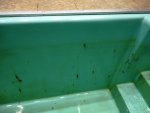Because I am a pool owner (and a retired guy), I am in charge of my church's baptistry. For several years we keep water all the time in the baptistry and warm it up every Saturday in case someone wants to be baptised on Sunday. The baptistry is fiberglass, about 400 gallons. I maintain the chemistry pretty much like a pool, 30 ppm CYA, 70 TA. I bump the chlorides to shock (12 ppm) on Sunday after services and the next Sunday I still have 2-3 ppm chlorine remaining. I drain, clean, and refill every other month. (We really don't have many baptisms. Most of the time no one is baptized between fillings.)
The sidewalls, and to a lesser extent, the floor have been looking pretty bad for a while, and I am sure the constant filling and chemicals do not help. (See the photo.) I would like to paint the baptistry so it looks better, to protect the walls, and extend the life of the baptistry. I would like the paint to last a while, 5-10 years. From reading, epoxy pool paint seems like my best bet. Any suggestions on prep and brand of paint?
Thanks!
The sidewalls, and to a lesser extent, the floor have been looking pretty bad for a while, and I am sure the constant filling and chemicals do not help. (See the photo.) I would like to paint the baptistry so it looks better, to protect the walls, and extend the life of the baptistry. I would like the paint to last a while, 5-10 years. From reading, epoxy pool paint seems like my best bet. Any suggestions on prep and brand of paint?
Thanks!


